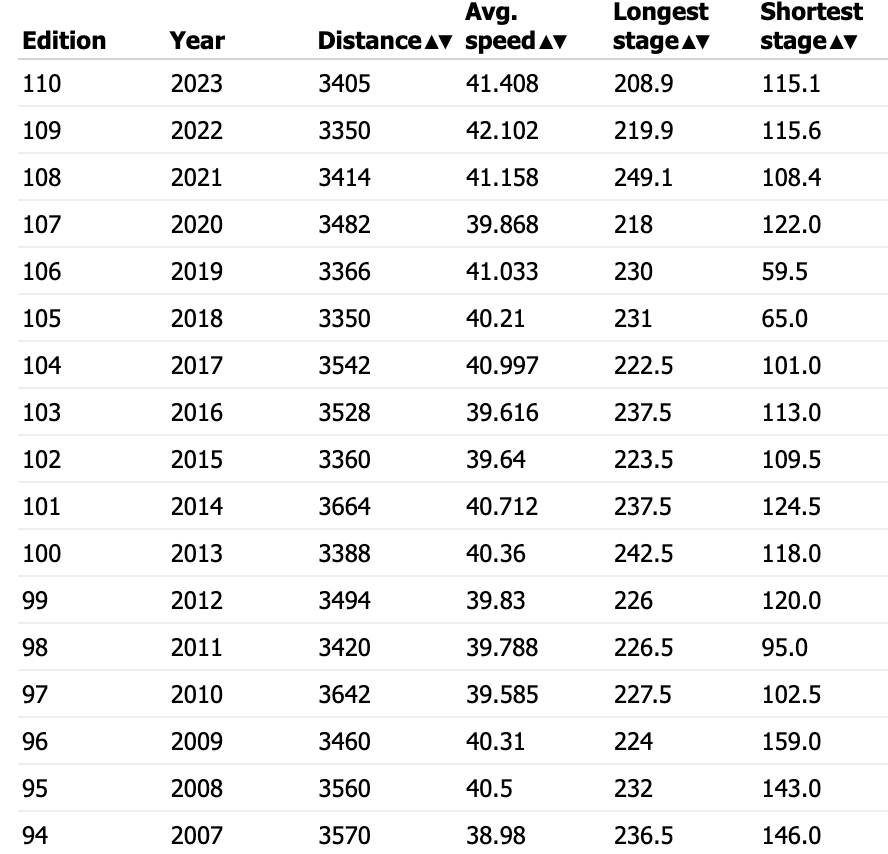Why is The Tour de France Getting Faster?
The Tour de France is getting faster and faster, and Whit Yost has some legal and reasonable reasons why that might be.
Faster is not an anomaly, it’s a trend. The last two men’s Tours de France were two of the three fastest in history. According to data gathered by ProCyclingStats, the Tour de France has been getting steadily faster over the years. But why? Well, it’s complicated, but we think we have some answers.
The Tour is getting shorter
Well, there’s a simplest and mathematically-obvious reason why the Tour is getting faster: the race is getting shorter. The overall distance of the Tour has been steadily decreasing over the past several decades. Once upon a time, stages were commonly longer than 200 kilometres, with some days exceeding 250. But today’s Tour organisers realise that more doesn’t always equal better, and that’s why they’re favouring shorter, punchier stages to liven up the action and encourage more aggressive tactics.

Stage 19 was a perfect example: even at the end of the Tour’s third week–when the riders were most fatigued–the 172km stage from Moirans-en-Montagne to Poligny was raced more like a spring Classic than a transitional stage the day before the Tour’s final mountain showdown. Had the stage been longer–or come at the end of a longer Tour–we might have seen fewer attacks, less risks being taken, and a more boring –and slower–stage. Shorter stages are generally faster stages; and shorter Tours are generally faster Tours.
Riders are training more effectively
Back in the day, riders built their training bases with long, slow rides in the off-season, attended a few warm weather training camps with their teams, and then raced themselves into shape once the season began. But that changed at the beginning of the 21st century when riders started limiting their racing programs in favour of specific training blocks in controlled environments, realising that racing is an imperfect form of training because there are too many variables involved.. The process was helped by the popularity of the power meter, which made their training even more focused and efficient.
Today, teams spend much of their seasons preparing for their goals at training camps, often at high altitude, with teams of coaches, physiologists, and nutritionists guiding the riders every step of the way. The result is the most well-trained–and fastest–peloton we’ve ever seen. It’s no coincidence that Denmark’s Jonas Vingegaard rides for Jumbo-Visma–one of the sport’s most meticulous teams–and has won each of the last two Tours de France, two of the fastest in Tour history.
Bikes are faster
The bikes being ridden in the Tour de France have also evolved, and teams are continuing to find new ways to use their equipment to squeeze every watt out of their riders. The bikes are stiffer, more aerodynamic, and more efficient, which definitely helps increase the Tour’s average speed.
For example, Victor Campenaerts (Lotto Dstny) was named the Tour’s Most Aggressive Rider, and the Belgian spent much of the Tour’s final week on the attack. He played a big role in driving the breakaway on Stage 19, which ended up being the fifth-fastest Tour de France road stage in Tour history–despite lots of climbing and a headwind.
Campenaerts is one of many riders in the peloton who has embraced the concept of marginal gains, which is why he races on narrow handlebars with his brake levers bent inward. He uses a single-chainring set-up with an internally-geared rear hub that offers him as many gears as he would have with two chainrings and a front derailleur. His aero wheels are often deeper than those used by other riders on similar terrain. In other words, he understands and appreciate the science of making his bike as aerodynamic and efficient as possible–and he’s not alone.
Even clothing has made the race faster: riders don’t just wear jerseys and bib shorts anymore, now they wear one-piece speed suits that offer all the comfort of traditional kits while being lighter and more aerodynamic. And aero-helmets cut down on drag without sacrificing ventilation and comfort. These gains might seem minimal, but add them up over the course of a 3-week grand tour and they make a big difference.
Teams have more (and better) resources
There used to be natural ebbs and flows within a race as riders sent their domestiques back to the team car for water, food, and information about the road ahead. When a team saw one rider go back to the car, they would send one of theirs as well, and before you knew it, the entire peloton was taking a “break” from the action to refuel. These lulls in the action kept speeds down.
But now teams have radios, GPS units, and staff at multiple positions along the course to give them bottles, gels, and information. This means less of a need to send teammates back to the caravan, and fewer drops in speed as a result. Thierry Giouvenou, the man who essentially designs the course each year, cited this as one of the reasons for the Tour’s faster speeds in a conversation with The Cycling Podcast.
Teams also have resources like VeloViewer software at their disposal, which allows them to study the course in detail and pass that knowledge to their riders before the stage in pre-race meetings and during the race itself via their radios.
By themselves these innovations are miniscule, but when combined, they’ve changed the sport forever, making a generation of riders who are better trained, better equipped, better informed, and of course, faster than their predecessors .
READ MORE ON: cycling history jonas vingegaard pro racing speed Tour de France

